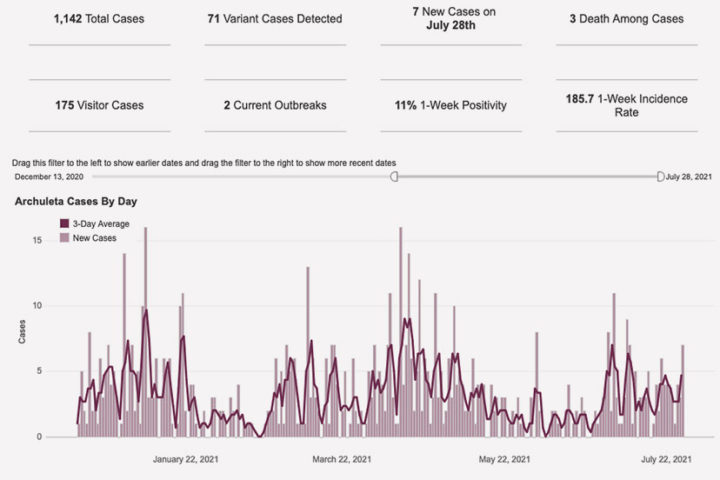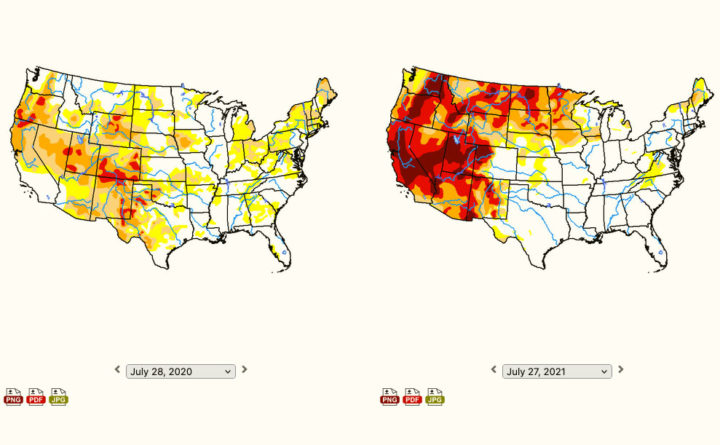More alarmingly, Candice Hasenyager, the deputy director of Utah’s Division of Water Resources, told the AP that this record was set months before water levels in the Great Salt Lake typically reach the yearly minimum. That indicates the lake could continue drying up as the summer progresses and heat continues to take its toll…
— from a story by Tom McKay on Gizmodo.com, ‘Utah’s Great Salt Lake Is Officially at Its Lowest Point in Recorded History.”
Some of our readers may have experienced an unusually fierce hail storm that swept through Pagosa yesterday afternoon. No doubt our metal roof contributed to the dramatic effect.
I’ve lived here 28 years and can’t recall a hail storm quite like it. It was actually exciting to watch. Then, it was over.
We discussed briefly, yesterday in Part One, the strange progression of the COVID pandemic in various countries, which has been exciting to watch, in its own way.
It’s impossible to draw firm conclusions from the disparate information appearing in various news articles. Are the vaccines working? Pfizer claims they are, but now wants to give everyone a ‘booster’ shot. (How many billions of dollars in added profits would accrue to the company, from that vaccination strategy?)
Most of the websites I visited yesterday indicate that about 50% of the American population is “fully vaccinated.” (But might still need booster shots.) But cases seem to be increasing in certain parts of the country.
Also mentioned yesterday, the percentage of fully vaccinated citizens in India is reportedly around 7%. But cases have been declining dramatically since early May, in spite of the Delta variant’s brooding presence.
And in the UK, the vaccination rate is about… well, who really knows? The New York Times reports that about 56% of UK citizens have been fully vaccinated. The Washington Post reports “more than 70%” are fully vaccinated. So maybe we’re not quite sure what’s going on? Cases reportedly shot up in June, but right at the moment are on a big downward trend.
Masks have reappeared as fashion statements here in Pagosa Springs, while new cases have been tracking at around the same frequency since mid-December… an average of about three new cases per day.
Three people, here, have died of COVID since the start of the pandemic. According to San Juan Basin Public Health, about 49% of the community has been fully vaccinated, which aligns nicely with the overall US rate (50%).
But the CDC data for 6am July 29 puts the number of fully vaccinated Archuleta County residents at 29%.
When we look at the graph above, we can’t see any evidence that, by fully vaccinating somewhere between 29% and 49% of the people in Archuleta County since December 1, we’ve produced a noticeable reduction in the number of new cases.
There’s some kind of crisis going on, but we’re not sure if it’s mostly a medical crisis, or mostly an information crisis.
Which leads nicely into another ‘crisis’ that has hit the American Southwest… as if COVID, polarized politics, and a national housing shortage/eviction crisis to rival the Great Depression weren’t enough to worry about.
Here’s a link to the story on Gizmodo.com mentioned at the top of the page: ‘Utah’s Great Salt Lake Is Officially at Its Lowest Point in Recorded History.”
The American Southwest has seen some unusual weather the past couple of years. This summer, a number of areas around the American West experienced record high temperatures, and the University of Nebraska ‘Drought Monitor’ shows a good deal of “Extreme Drought” (Red) and “Exceptional Drought” (Dark Red) in the map for the week of July 27, 2021.
That’s the map on the right side of this image:
The map on the left, meanwhile, shows the week of July 28, last year. As we note, the Southwest was seeing some “Abnormally Dry” areas (Yellow and Orange) but the largest area of “Extreme Drought” (Red) was right around Pagosa Springs. (On the 2021 map, Pagosa is in the “Yellow” zone.) Obviously, ‘Drought’ — mild or extreme — comes and goes depending on the weather. Pagosa Springs, in spite of being in “Extreme Drought” last July, started out the spring of 2021 with all of our water reservoirs full.
But what about this “Lowest Point in Recorded History” claim, at the Great Salt Lake in Utah? That sounds pretty serious. If we look at the July 2021 map above (on the right) you see the entire State of Utah in “Exceptional Drought” or “Extreme Drought”. Given those conditions, you might expect a saltwater lake, located in the northern part of the state, to be experiencing low water levels.
The lake is currently down 11 feet ‘below average’, and it could go even lower.
In June, Utah Governor Spencer Cox asked the citizens of Utah to pray for rain to end the drought.
That apparently didn’t help. We’re not sure if prayer is simply an unproductive solution — for the Great Salt Lake, in particular, and also for Utah as a whole — or if perhaps Utah’s piety isn’t up to the required standards.
Sometimes it helps to take the long view, in these situations. Reportedly, the last time the Earth experienced atmospheric concentrations of carbon dioxide above 420 parts per million (ppm), the continent we know as North America looked something like this (according to the people who theorize about this kind of stuff):
It’s easy to assume that the Great Salt Lake — the largest saltwater lake in the Western Hemisphere — is the last remaining remnant of what was once an enormous inland sea. Looking at things from that perspective, a decline of 11 feet seems like a rather minor geological change. Relatively speaking.
Those of us in the media business, however, are always on the lookout for something that seems dramatically wrong. The more dramatic, the better.
(Thus, I’ve posted a picture, above, showing the entire State of Colorado under water. Hard to beat that, for drama.)
From the Gizmondo article:
The drought in the West isn’t expected to improve anytime soon. Ryan Rowland, the data chief at the USGS’s Utah Water Science Center, told NBC News that “we think [the Great Salt Lake] could drop another foot to a foot and a half” over the rest of the year.
What will happen to the Great Salt Lake is between us and Mother Nature, of course.
But an even stranger situation is unfolding in southern California, where no less an authority than Food & Wine magazine is reporting on “water thieves” making off with millions — maybe billions — of gallons of water.
Over 12 billion gallons of water have likely been stolen in California since 2013, John Nores — the former head of the California Department of Fish and Wildlife Marijuana Enforcement Team — recently told CNN…
“Any way that you can imagine that somebody is going to grab water, they’re doing it,” Mendocino County Sheriff Matt Kendall told the Desert Sun. Filling trucks with water from rivers and lakes? Check. Creating illegal dam systems to divert water to new reservoirs? Check. Swiping water from homes and businesses and wells? Check. Even tapping directly into water mains is apparently not off limits.
And of course, fire hydrants are a target. In part of the Antelope Valley, officials reportedly removed 100 of the area’s existing 176 hydrants, leaving only the ones that were deemed essential — and then putting locks on them. That was after thieves took so much water it nearly crashed the entire water system for hundreds of homes…
No, it’s not the vineyards stealing the water, according to Food & Wine magazine. The culprits? Illegal marijuana growers.
Or so they tell us.






